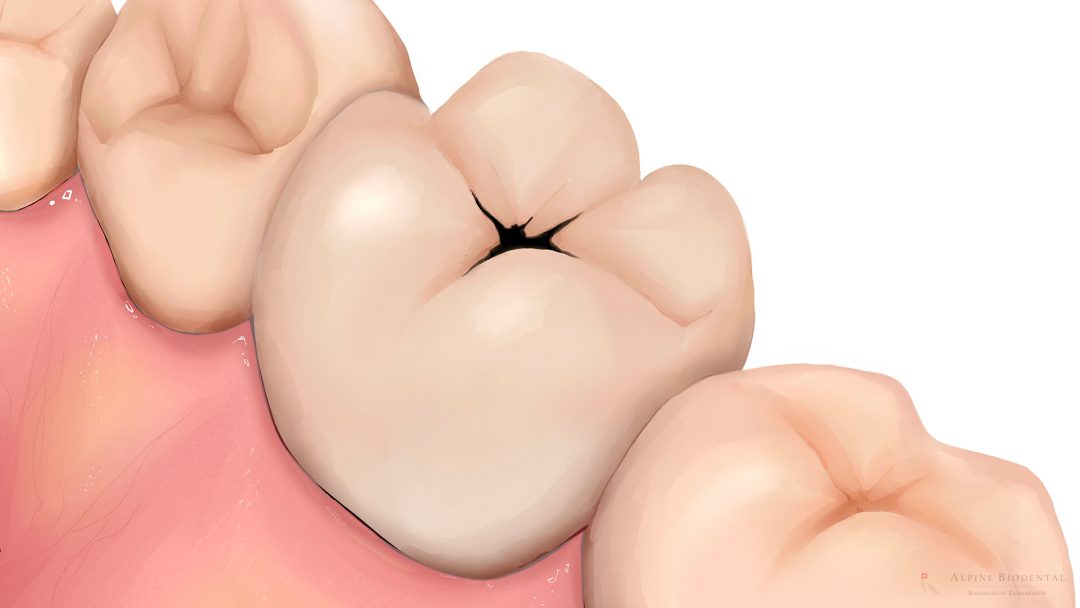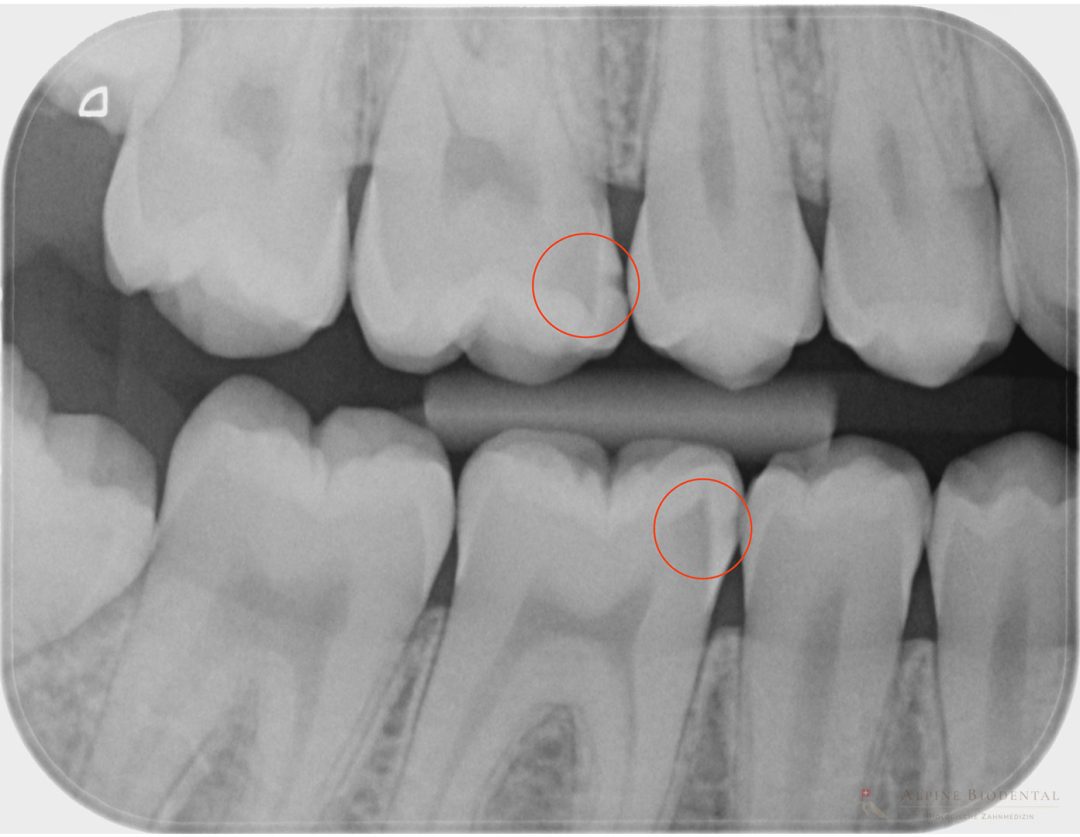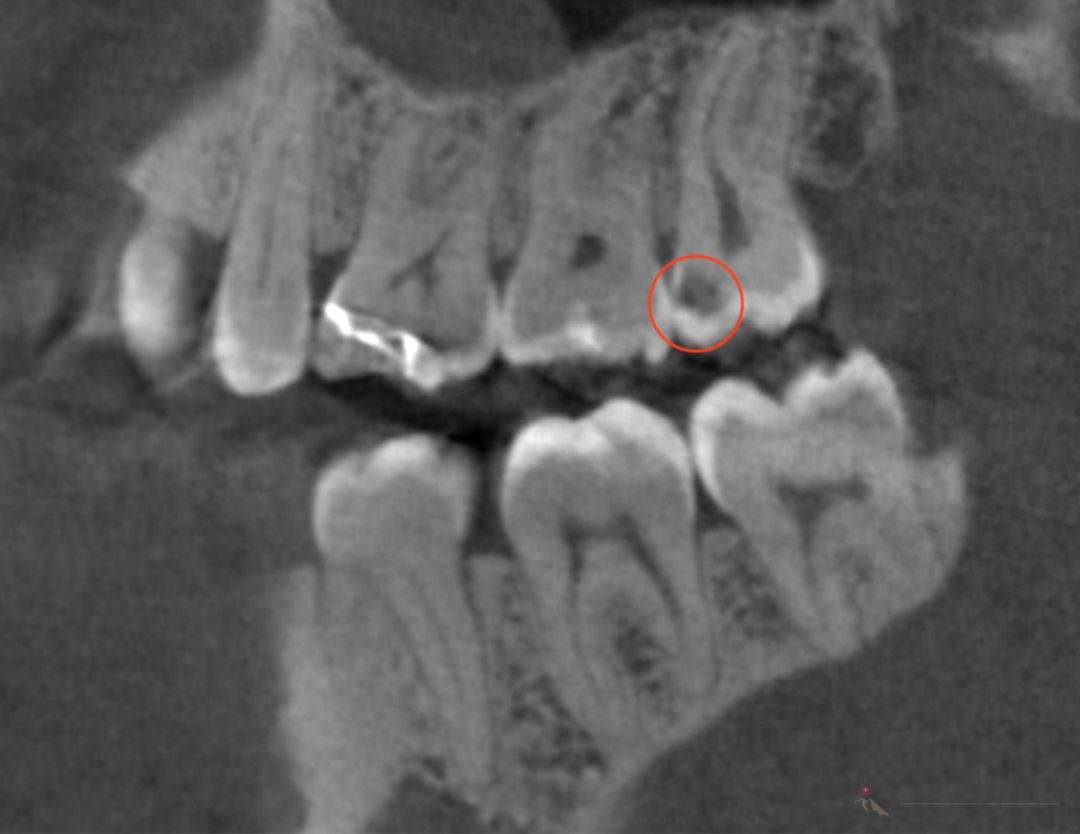Caries

Caries, commonly known as tooth decay or “cavities,” is a widespread dental condition. The acid produced by caries-causing bacteria can dissolve the tooth, leading to the formation of a hole in the tooth structure. Patients with caries often experience toothaches and should promptly seek dental attention.
What is Caries?
Caries refers to a dental condition in which the tooth structure is softened and destroyed due to the acidic action of bacteria. It is understandable why caries is also referred to as “decayed teeth” or “rotten teeth.”
The destroyed, carious area of the tooth is no longer hard and healthy but soft and dissolved. This soft matter consists of dissolved tooth substance, oral bacteria, components of saliva, and food particles. The color of the soft carious mass corresponds to the tooth color, with time allowing particles from food to darken it.
In advanced stages of caries, a hole forms in the tooth, weakening it and significantly increasing the risk of breakage during chewing.
How does Caries develop?
Caries develops as caries-causing bacteria, which thrive on the tooth surface, convert sugars and carbohydrates from the diet into acid. This acid can soften and destroy the tooth. Teeth have limited protection against acid, leading to tooth destruction from acid exposure. Acid-producing bacteria, such as Streptococcus mutans, can produce significant amounts of acid in a small space and time, causing localized dissolution and destruction of the tooth.
The presence of caries-causing bacteria is the primary requirement for developing caries. These harmful bacteria are capable of producing large amounts of acid only when they form a strong colony. Such a robust colony manifests as dental plaque on the teeth, resulting from inadequate oral hygiene. Therefore, the second requirement for caries is the presence of plaque containing numerous caries-causing bacteria, indicating poor oral hygiene.
The abundance of caries-causing bacteria in dental plaque depends on their access to sugar and carbohydrates for nourishment. These components serve as their fuel, which they metabolize into acid. By reducing the supply of sugar, less acid is produced as a byproduct, thereby sparing the teeth. Thus, the third requirement for caries is the presence of sugar and carbohydrates in the diet.
Once these three conditions are met, caries formation is only a matter of time. If caries-causing bacteria, present in dental plaque, convert the supplied sugar molecules into acid over a period, caries will inevitably develop.
Stage 1: Initial Caries / Early Stage
The first stage in caries development is known as initial caries or “early-stage caries.” In this stage, the destruction of the tooth is confined to the enamel, the outermost and hardest layer of the tooth.
In initial caries, the surface of the tooth usually remains intact, without the formation of a hole in the enamel. The body can often self-repair initial caries under conducive conditions, leaving only a superficial discoloration with purely aesthetic implications.
In the early stages of caries, treatment (drilling and filling) of the tooth can often be avoided.
Stage 2: Superficial Dentin Caries
If caries penetrates through the enamel into the dentin, it becomes superficial dentin caries. Dentin is softer and more vulnerable than enamel, and it surrounds the dental pulp, the nerve center of the tooth. At this stage, occasional pain may occur, especially with cold or sweet stimuli. In cases of superficial dentin caries, drilling may often be unnecessary and should be evaluated by an experienced dentist.
Stage 3: Deep Dentin Caries
Deep dentin caries occurs when caries penetrates deeper into the dentin. This stage is associated with more intense tooth pain. Given the proximity of caries to the dental pulp, deep dentin caries poses a significant threat to the tooth. The carious lesion contains bacteria, acids, and remnants of food. If the stimulation of the dental pulp becomes too intense, severe pain may occur, and the tooth may die.
Stage 4: Caries in the Dental Pulp
In the fourth stage of caries development, caries has reached the dental pulp. The tooth is either in the process of dying or is already dead. If the tooth dies, severe throbbing pain and pain upon biting may occur. X-rays often reveal inflammation at the root tip.
Once caries reaches the dental pulp, root canal treatment or tooth extraction is necessary.
This state could have been prevented by seeking dental care earlier. Therefore, regular check-ups and prophylactic sessions with an experienced dentist are of paramount importance.
What does Caries look like?
Active and highly acidic caries typically appears as a whitish cavity in the tooth. The rapid breakdown of the tooth prevents food dyes from darkening the caries. In contrast, passive and slower-progressing caries may present as dark or even black. Differentiating between caries and discoloration can be challenging, so color alone is not a reliable indicator.
Caries is characterized by localized demineralization of the tooth, often accompanied by the presence of a hole. The size of the hole can vary from small to more extensive. However, it is crucial to note that a hole in the tooth does not always indicate caries. Natural pits or a broken piece of the tooth can also create holes. If a small hole is self-identified, it is generally not a cause for concern.
The most effective way to diagnose caries is through a dental examination by an experienced dentist. X-rays, such as bitewing radiographs, can be used for precise caries diagnostics. In X-ray images, caries appears dark and is often found between teeth or beneath old fillings. Hidden caries under a crown can also be detected in X-ray images.
Symptoms of Caries
Incipient caries is usually symptom-free and is not noticed by the patient. However, if the caries has penetrated the enamel and reached the dentin, the first symptoms may appear. For example, the patient notices pain after eating sweets or in cold weather.
If the caries has penetrated deeper, towards the tooth nerve, it can lead to permanent pain and death of the tooth. The death of the tooth is usually very unpleasant and associated with throbbing and radiating pain. If this happens, root canal treatment or removal of the tooth is necessary.
Caries on molars is more common than caries on incisors because the spaces between the molars are better suited for caries to develop.
Wisdom teeth are particularly prone to cavities. The reason for this is that they are at the very back of the row of teeth, often have too little space and are difficult to clean.
Caries Diagnosis
Caries can be recognized based on its appearance and tooth structure. Dentists visually examine the teeth, preferably using magnifying glasses and a bright headlamp. This method can uncover most carious lesions.
However, caries can often hide between teeth and may require additional tools for representation.
Bite Wing Radiographs
Bite wing radiographs, small X-ray images, are useful for evaluating caries between teeth (interdental spaces) precisely. They also aid in diagnosing caries under crowns or fillings. Caries in the early stages (initial caries) can also be easily detected with bitewing radiographs.
Bite-wing radiographs are recommended every 2 to 5 years to detect caries early.

Cone-Beam-Tomographie (CBCT)
The latest generation of Cone-Beam-Tomographie (CBCT) is highly suitable for revealing hidden caries. If a three-dimensional dental X-ray is necessary, it can often replace bite-wing radiographs.

Caries Detector
A caries detector is a liquid capable of staining caries. Dentists often use it during caries removal to ensure the complete elimination of carious tissue. Home use is strongly discouraged, as the caries detector can permanently color the teeth red or blue, depending on the type.
Treatment
When caries has penetrated into the dentin, dental treatment is recommended. The treatment involves the careful removal of carious tissue with a small drill. It is crucial to avoid damaging the dental pulp during caries removal, as nerve injury can lead to tooth death, necessitating extraction or root canal treatment. Additionally, dentists aim to preserve as much natural tooth structure as possible during the process.
In most cases, caries treatment can be performed under local anesthesia. However, for patients with severe caries and dental anxiety, the entire procedure can be carried out under general anesthesia. After caries removal, the tooth defect is restored using a composite filling, ceramic filling, or ceramic crown.
It is strongly advised against attempting to remove or treat caries independently; only an experienced dentist should perform such procedures.
Preventing Caries
Preventing caries can help maintain healthy teeth over the long term, emphasizing the importance of dental hygiene.
Many patients express frustration about developing caries despite daily tooth brushing. The reason lies in the oral flora harboring many disease-causing bacteria. This is true even for milk teeth, which can develop cavities despite regular brushing.
The most effective way to prevent caries is to maintain a consistently healthy oral flora. Plasma and ozone treatment can optimize the flora by eliminating acid-producing bacteria while allowing beneficial bacteria to thrive. This promotes the development of a healthy oral environment.
Caries in Children
Caries in children occurs when parents transfer their caries bacteria to their children. As a result, the healthy milk teeth become diseased caries teeth. This process is particularly aggravated if children eat a lot of sweets and their teeth are not brushed well.
It is also very important to treat decay in milk teeth so that the teeth do not have to be extracted prematurely.
To prevent tooth decay in milk teeth, it is also essential to improve the bacterial flora in children.
Dr. med. dent. Artur Hein
Caries should not go unnoticed, otherwise the tooth can become permanently damaged. Our team is happy to assist you.

Frequently asked Questions about Caries
Caries is a very widespread problem in the population and raises many different questions.
The following questions and answers should provide you with more clarity on this extensive topic.
Caries can look very similar to discoloration. It is often difficult to tell at home in the mirror whether it is a caries or discoloration. A reliable diagnosis can only be made by your dentist.
You can only reliably detect tooth decay at the dentist.
Caries is often hidden in the spaces between teeth. In such cases, even the dentist, with magnifying glasses and a bright headlamp, has difficulty making an accurate diagnosis. Additional aids, such as Bite-Wing X-rays, provide valuable support in visualizing hidden caries.
This depends very much on the bacterial flora. If a lot of caries bacteria are present, caries can worsen within days or weeks. It is advisable not to wait too long and to make an appointment with your dentist.
Yes, tooth decay is contagious. The cause of tooth decay is the caries bacteria in the oral cavity. These are transferred from one person to another. This is how parents transfer their bacterial flora to their children. If the oral flora has a high number of caries bacteria, the children will develop caries in the future just like their parents.
Drilling is not always necessary for caries. The procedure always depends on the localization, extent and depth of the caries.
In the case of advanced caries, drilling with a small drill is usually necessary.
It is important to proceed carefully during removal and not to destroy too much tooth substance.
Yes, a tooth is severely weakened by decay and can break off more easily.
It often happens that half a molar tooth breaks off and a large cavity becomes visible underneath.
Very often a caries can form under a filling (e.g. plastic filling) or crown (e.g. ceramic crown). In such cases, it is necessary to remove the entire filling and crown and clean the caries carefully but thoroughly. The tooth is then restored with a filling or crown.
A black spot on the tooth does not always have to be a cavity. It can also be a harmless discoloration or a hardened initial caries. Your dentist can tell you exactly what it is.
Many patients constantly get tooth decay and wonder what they can do about it.
The main reason for this is the bacterial flora in the oral cavity. If too many acid-forming bacteria are present, it is difficult to stop the formation of new caries. In such cases, it is essential to optimize the oral flora in the long term. We will be happy to help you.
There are some home remedies that can help with tooth decay. However, they are not very effective.
- Baking soda (sodium hydrogen carbonate or soda) is a buffer and can neutralize the acidity of the caries bacteria to a certain extent. You can therefore rinse with baking soda several times a day.
- Oil pulling with coconut oil or olive oil can also have a supportive effect. The old Ayurvedic method involves putting a little oil in the mouth and rinsing with it for about 15 minutes.
Yes, tooth decay can lead to bad breath. Large amounts of bacteria and food residue can accumulate in the caries. This can lead to bad breath in those affected.
Smoking causes an unfavorable change in the bacterial flora, which increases the number of caries bacteria. The result is more tooth decay and periodontitis.
Further information
Here you will find further information on the subject for a deeper insight.